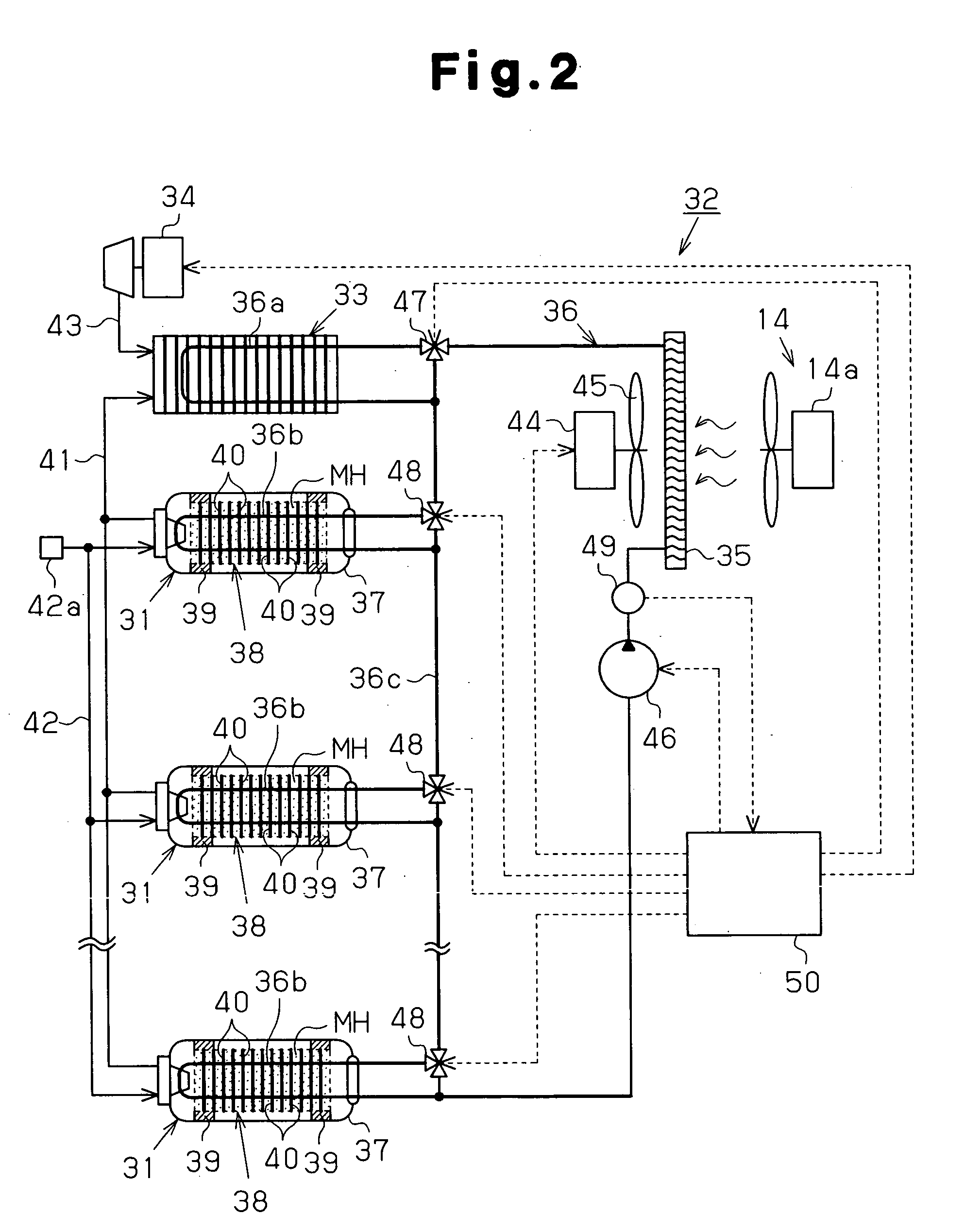Hydrogen station, method of charging hydrogen, and vehicle
a hydrogen station and hydrogen technology, applied in the direction of vehicle heating/cooling devices, packaging, liquid transfer devices, etc., can solve the problems of large hydrogen tank, complex structure of hydrogen tanks, and high time requirements for hydrogen charging, so as to shorten the time for hydrogen charging and efficiently cool the radiator
- Summary
- Abstract
- Description
- Claims
- Application Information
AI Technical Summary
Benefits of technology
Problems solved by technology
Method used
Image
Examples
first embodiment
[0023] A first embodiment of the present invention will now be described with reference to FIGS. 1 and 2.
[0024] As shown in FIG. 1, a hydrogen station 11 includes gas storage equipment 12 for storing hydrogen gas, a dispenser (charger) 13 for charging hydrogen gas supplied from the gas storage equipment 12 into a plurality of hydrogen tanks 31 installed in a vehicle 30, and a blower 14. In FIG. 1, the ratio between the sizes of the vehicle 30, the gas storage equipment 12, the dispenser 13, the blower 14 and the like differs from actual size.
[0025] The vehicle 30 is a fuel cell automobile, of which the drive source is a fuel cell, and includes a fuel cell system 32. As shown in FIG. 2, the fuel cell system 32 includes the hydrogen tanks 31, a fuel cell 33, a compressor 34, and a radiator 35. A heat medium flow passage 36 connects the hydrogen tanks 31, the fuel cell 33, and the radiator 35. There are four hydrogen tanks 31 as shown in FIG. 1, but only three hydrogen tanks 31 are s...
second embodiment
[0054] A second embodiment of the present invention will now be described with reference to FIG. 3 focusing on the differences from the first embodiment. Components that are the same as the first embodiment are denoted with the same reference numbers and will not be described in detail. In the present embodiment, the hydrogen station 11 includes a cooling device 20, and the blower 14 blows air, which is cooled in the cooling device 20 to a temperature lower than the ambient temperature, towards the radiator 35.
[0055] As shown in FIG. 3, the cooling device 20 is arranged between the vehicle parking area of the hydrogen station 11 and the blower 14. The cooling device 20 is an evaporator forming part of, for example, a refrigeration circuit. Other components (compressor, condenser, expansion valve, etc.) of the refrigeration circuit are not shown. A refrigeration circuit having a known configuration may be used as the refrigeration circuit. The cooling device 20 includes a pipe throu...
third embodiment
[0058] A third embodiment of the present invention will now be described with reference to FIG. 4 focusing on the differences from the first embodiment. Components that are the same as the first embodiment are denoted with the same reference numbers and will not be described in detail. The present embodiment relates to a vehicle 30 enabling efficient cooling of the radiator 35 with a fan (i.e., blower arranged in the hydrogen station 11) located outside the vehicle 30 when charging hydrogen at the hydrogen station 11. The structure of the hydrogen station 11 is the same as that in the first embodiment, and the fuel cell system installed in the vehicle 30 is the same as that in the first embodiment.
[0059] A compartment 51 equivalent to an engine room of a vehicle using an internal combustion engine as the driving source is defined at the front of the vehicle 30. The radiator 35 is arranged toward the front of the vehicle 30 in the compartment 51. A front grille 53 is integrally form...
PUM
| Property | Measurement | Unit |
|---|---|---|
| pressure | aaaaa | aaaaa |
| current velocity | aaaaa | aaaaa |
| temperature | aaaaa | aaaaa |
Abstract
Description
Claims
Application Information
 Login to View More
Login to View More - R&D
- Intellectual Property
- Life Sciences
- Materials
- Tech Scout
- Unparalleled Data Quality
- Higher Quality Content
- 60% Fewer Hallucinations
Browse by: Latest US Patents, China's latest patents, Technical Efficacy Thesaurus, Application Domain, Technology Topic, Popular Technical Reports.
© 2025 PatSnap. All rights reserved.Legal|Privacy policy|Modern Slavery Act Transparency Statement|Sitemap|About US| Contact US: help@patsnap.com



